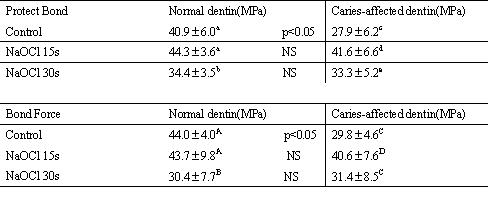ABSTRACT: 0953
Improvement of Bond Strength to Caries-Affected Dentin
| G. TANIGUCHI1, S. KUNAWAROTE1, K. HOSAKA2, N. IWAMOTO1, M. IKEDA1, M. NAKAJIMA1, and J. TAGAMI3, 1Tokyo Medical & Dental University, Japan, 2Tokyo Medical and Dental University Graduate School, Japan, 3Tokyo Medical and Dental University & COE Program, FRMDRTB at TMDU, Japan | |
Objectives: The purpose of this study was to evaluate the effect of pre-treatment of NaOCl on bonding to caries-affected and normal dentin. Methods: Twenty extracted human molars with coronal carious lesions were used in this experiment. The teeth were ground in order to expose the caries-affected dentin and surrounding normal dentin. Six percent NaOCl was applied for 0, 30 and 60s. Two self-etch systems (Clearfil Protect Bond; Kuraray medical and Bond Force; Tokuyama) were applied to flat dentin surfaces with normal and caries-affected dentin according to manufacture's instructions. After 37°C water storage, 24h, the bonded caries-affected dentin or normal dentin areas were isolated to create an hourglass configuration with a cross-sectional area of approximately 1 mm2. The specimens were subjected to tensile stress at a crosshead speed of 1.0 mm/min. The interfaces of caries-affected and normal dentin treated with NaOCl were examined with SEM. Results:( meanąSD; N=12) Different letters indicate statistically significant differences. NS = no significant difference Statistical Analyses were carried out by two-way ANOVA and post hoc test (T-Test and Bonferroni) Conclusion: For both control groups, caries-affected dentin had significantly lower bond strength than normal dentin. However NaOCl treatment to dentin surface for 15 s could improve bond strength to caries-affected dentin.
| |
| Seq #105 - Interface 3:30 PM-4:45 PM, Thursday, July 3, 2008 Metro Toronto Convention Centre Exhibit Hall D-E | |
|
Back to the Dental Materials 1: Adhesion - Bond Strength Testing and Mechanisms Program | |
©Copyright 2008 American Association for Dental Research. All Rights Reserved.
